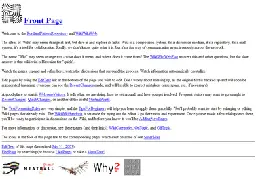
YouTube Video
Click to view this content.
cross-posted from: https://lemmy.capebreton.social/post/2509054
> On April 9, 1999 the Domain Controllers for the redmond.corp.microsoft.com Windows NT4-based domain were upgraded to a pre-release version of Windows 2000 Server and thus became the world’s first production Active Directory domain:
86-DOS would later be bought by Microsoft and take over the computing world.
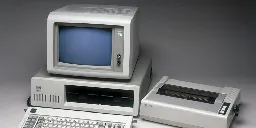
Short biography of John von Neumann, who helped developed von Neumann architecture.

There is nothing stopping it.
Proper verification is a good start.


cross-posted from: https://lemmy.capebreton.social/post/1302050
> > Microsoft Ships Internet Explorer 2.0 > November 27, 1995 > > Microsoft Corp. shipped Internet Explorer 2.0, starting a browser war with the popular Netscape Navigator. Netscape Communications Corp. had had a virtual monopoly on World Wide Web browsers since the infancy of the web. The Netscape Navigator and Communicator browsers serve as a format for viewing and creating World Wide Web pages, as well as participating in newsgroups and sending e-mail. Microsoft promotes its Internet Explorer with specific mention of its privacy and encryption.


cross-posted from: https://lemmy.capebreton.social/post/1302050
> > Microsoft Ships Internet Explorer 2.0 > November 27, 1995 > > Microsoft Corp. shipped Internet Explorer 2.0, starting a browser war with the popular Netscape Navigator. Netscape Communications Corp. had had a virtual monopoly on World Wide Web browsers since the infancy of the web. The Netscape Navigator and Communicator browsers serve as a format for viewing and creating World Wide Web pages, as well as participating in newsgroups and sending e-mail. Microsoft promotes its Internet Explorer with specific mention of its privacy and encryption.


cross-posted from: https://lemmy.capebreton.social/post/1302050
> > Microsoft Ships Internet Explorer 2.0 > November 27, 1995 > > Microsoft Corp. shipped Internet Explorer 2.0, starting a browser war with the popular Netscape Navigator. Netscape Communications Corp. had had a virtual monopoly on World Wide Web browsers since the infancy of the web. The Netscape Navigator and Communicator browsers serve as a format for viewing and creating World Wide Web pages, as well as participating in newsgroups and sending e-mail. Microsoft promotes its Internet Explorer with specific mention of its privacy and encryption.

YouTube Video
Click to view this content.
cross-posted from: https://lemmy.capebreton.social/post/1207163
> For a brief moment, Nortel Networks was on top of the world. Let's enjoy that moment while we can. Part 1 of 2.

YouTube Video
Click to view this content.
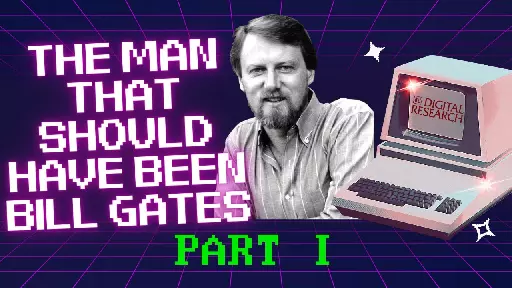
YouTube Video
Click to view this content.
cross-posted from: https://lemmy.capebreton.social/post/557460
> This three part documentary covers the lifetime and story of the man who was robbed from being Bill Gates, Gary Kildall. > > Dive into the untold story of Gary Kildall, the overlooked genius who laid the foundation stones of the personal computing revolution with his groundbreaking CP/M operating system. > > In this eye-opening exposé, we unravel the momentous journey of a tech maestro who could have been in the limelight, akin to Bill Gates, but was tragically edged out by the fierce market strategies of Microsoft and IBM. Uncover the dramatic twists and the bitter rivalry that ensued as MS-DOS controversially eclipsed CP/M, bringing a sad and abrupt halt to Kildall's soaring career. > > Watch as we shed light on a saga brimming with innovation, rivalry, and heartbreak, echoing the turbulent early days of the software industry. > > Don't miss this deep dive into the life of a visionary who should have been etched in history as a titan of the tech world - Gary Kildall: the man who should have been Bill Gates. > > #GaryKildall #CPM #DigitalResearch #TechHistory #UntoldStories >
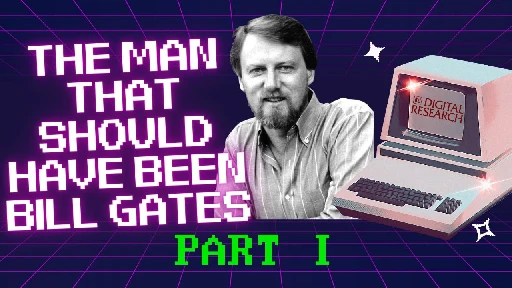
YouTube Video
Click to view this content.
cross-posted from: https://lemmy.capebreton.social/post/557460
> This three part documentary covers the lifetime and story of the man who was robbed from being Bill Gates, Gary Kildall. > > Dive into the untold story of Gary Kildall, the overlooked genius who laid the foundation stones of the personal computing revolution with his groundbreaking CP/M operating system. > > In this eye-opening exposé, we unravel the momentous journey of a tech maestro who could have been in the limelight, akin to Bill Gates, but was tragically edged out by the fierce market strategies of Microsoft and IBM. Uncover the dramatic twists and the bitter rivalry that ensued as MS-DOS controversially eclipsed CP/M, bringing a sad and abrupt halt to Kildall's soaring career. > > Watch as we shed light on a saga brimming with innovation, rivalry, and heartbreak, echoing the turbulent early days of the software industry. > > Don't miss this deep dive into the life of a visionary who should have been etched in history as a titan of the tech world - Gary Kildall: the man who should have been Bill Gates. > > #GaryKildall #CPM #DigitalResearch #TechHistory #UntoldStories >

YouTube Video
Click to view this content.
cross-posted from: https://lemmy.capebreton.social/post/557460
> This three part documentary covers the lifetime and story of the man who was robbed from being Bill Gates, Gary Kildall. > > Dive into the untold story of Gary Kildall, the overlooked genius who laid the foundation stones of the personal computing revolution with his groundbreaking CP/M operating system. > > In this eye-opening exposé, we unravel the momentous journey of a tech maestro who could have been in the limelight, akin to Bill Gates, but was tragically edged out by the fierce market strategies of Microsoft and IBM. Uncover the dramatic twists and the bitter rivalry that ensued as MS-DOS controversially eclipsed CP/M, bringing a sad and abrupt halt to Kildall's soaring career. > > Watch as we shed light on a saga brimming with innovation, rivalry, and heartbreak, echoing the turbulent early days of the software industry. > > Don't miss this deep dive into the life of a visionary who should have been etched in history as a titan of the tech world - Gary Kildall: the man who should have been Bill Gates. > > #GaryKildall #CPM #DigitalResearch #TechHistory #UntoldStories >
On September 9, 1947, a team of computer scientists reported the world’s first computer bug—a moth trapped in their computer at Harvard University.

cross-posted from: https://lemmy.capebreton.social/post/517037
> At 3:45 p.m., Grace Murray Hopper records 'the first computer bug' in the Harvard Mark II computer's log book. The problem was traced to a moth stuck between relay contacts in the computer, which Hopper duly taped into the Mark II's log book with the explanation: “First actual case of bug being found.” The bug was actually found by others but Hopper made the logbook entry.
There's a growing awareness about mental health across the industry, but many professionals told CyberScoop it's not enough.
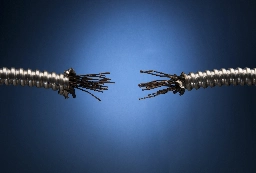
cross-posted from: https://lemmy.capebreton.social/post/506912
> More than a dozen cybersecurity professionals shared with CyberScoop similar stories stemming from the intense work demands of an industry that involves often 24/7 vigilance against a growing tide of cyberthreats. Despite a growing awareness of mental health struggles within the industry, sources said there still aren’t enough resources inside companies or across the broader cybersecurity community for professionals dealing with burnout, stress and the intense anxiety of working in a high-pressure environment...
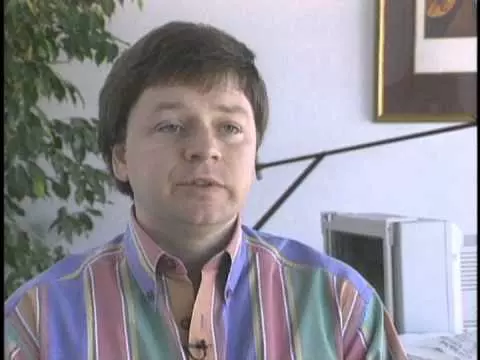
YouTube Video
Click to view this content.
cross-posted from: https://lemmy.capebreton.social/post/398084
> cross-posted from: https://lemmy.capebreton.social/post/397946 > > > Authors: > > > > Lorenzo Neil, North Carolina State University; Harshini Sri Ramulu, The George Washington University; Yasemin Acar, Paderborn University & The George Washington University; Bradley Reaves, North Carolina State University > > > > Abstract: > > > > Users have a wealth of available security advice --- far too much, according to prior work. Experts and users alike struggle to prioritize and practice advised behaviours, negating both the advice's purpose and potentially their security. While the problem is clear, no rigorous studies have established the root causes of overproduction, lack of prioritization, or other problems with security advice. Without understanding the causes, we cannot hope to remedy their effects. > > > > In this paper, we investigate the processes that authors follow to develop published security advice. In a semi-structured interview study with 21 advice writers, we asked about the authors' backgrounds, advice creation processes in their organizations, the parties involved, and how they decide to review, update, or publish new content. Among the 17 themes we identified from our interviews, we learned that authors seek to cover as much content as possible, leverage multiple diverse external sources for content, typically only review or update content after major security events, and make few if any conscious attempts to deprioritize or curate less essential content. We recommend that researchers develop methods for curating security advice and guidance on messaging for technically diverse user bases and that authors then judiciously identify key messaging ideas and schedule periodic proactive content reviews. If implemented, these actionable recommendations would help authors and users both reduce the burden of advice overproduction while improving compliance with secure computing practices. > > > > Open Access Media > > USENIX is committed to Open Access to the research presented at our events. Papers and proceedings are freely available to everyone once the event begins. Any video, audio, and/or slides that are posted after the event are also free and open to everyone. Support USENIX and our commitment to Open Access. > > > > Neil PDF > > View the slides
cross-posted from: https://lemmy.capebreton.social/post/397946
> Authors: > > Lorenzo Neil, North Carolina State University; Harshini Sri Ramulu, The George Washington University; Yasemin Acar, Paderborn University & The George Washington University; Bradley Reaves, North Carolina State University > > Abstract: > > Users have a wealth of available security advice --- far too much, according to prior work. Experts and users alike struggle to prioritize and practice advised behaviours, negating both the advice's purpose and potentially their security. While the problem is clear, no rigorous studies have established the root causes of overproduction, lack of prioritization, or other problems with security advice. Without understanding the causes, we cannot hope to remedy their effects. > > In this paper, we investigate the processes that authors follow to develop published security advice. In a semi-structured interview study with 21 advice writers, we asked about the authors' backgrounds, advice creation processes in their organizations, the parties involved, and how they decide to review, update, or publish new content. Among the 17 themes we identified from our interviews, we learned that authors seek to cover as much content as possible, leverage multiple diverse external sources for content, typically only review or update content after major security events, and make few if any conscious attempts to deprioritize or curate less essential content. We recommend that researchers develop methods for curating security advice and guidance on messaging for technically diverse user bases and that authors then judiciously identify key messaging ideas and schedule periodic proactive content reviews. If implemented, these actionable recommendations would help authors and users both reduce the burden of advice overproduction while improving compliance with secure computing practices. > > Open Access Media > USENIX is committed to Open Access to the research presented at our events. Papers and proceedings are freely available to everyone once the event begins. Any video, audio, and/or slides that are posted after the event are also free and open to everyone. Support USENIX and our commitment to Open Access. > > Neil PDF > View the slides
cross-posted from: https://lemmy.capebreton.social/post/347724
> Windows 95 is a consumer-oriented operating system developed by Microsoft as part of its Windows 9x family of operating systems. The first operating system in the 9x family, it is the successor to Windows 3.1x, and was released to manufacturing on July 14, 1995, and generally to retail on August 24, 1995, almost three months after the release of Windows NT 3.51. > > Windows 95 is the first version of Microsoft Windows to include taskbar, start button, and accessing the internet. Windows 95 merged Microsoft's formerly separate MS-DOS and Microsoft Windows products, and featured significant improvements over its predecessor, most notably in the graphical user interface (GUI) and in its simplified "plug-and-play" features. There were also major changes made to the core components of the operating system, such as moving from a mainly cooperatively multitasked 16-bit architecture to a 32-bit preemptive multitasking architecture, at least when running only 32-bit protected mode applications. > > Accompanied by an extensive marketing campaign,Windows 95 introduced numerous functions and features that were featured in later Windows versions, and continue in modern variations to this day, such as the taskbar, notification area, and the "Start" button. It is considered to be one of the biggest and most important products in the personal computing industry.
Just wanted to share new community I created for anything related to the Couch to 5k running programs & beginner running in general.
What is Couch 2 5k?
The official plan consists of ever-increasing intervals of running, interspersed with fast walking. It also relies on rest days to allow your body to build strength. The official plan takes 9 weeks in total to get you from absolutely no running ability, to running 5K non-stop. Other similar plans are available that may take a longer or shorter time to complete.
 videodrome @lemmy.capebreton.social
videodrome @lemmy.capebreton.social Admin of lemmy.CapeBreton
Mastadon: https://mstdn.ca/@videodrome
